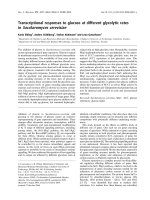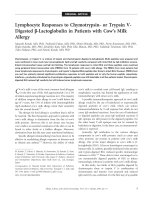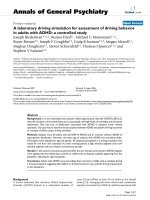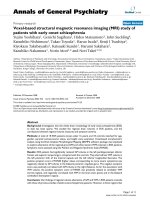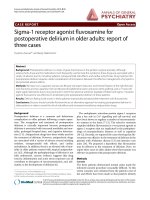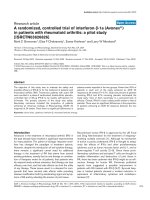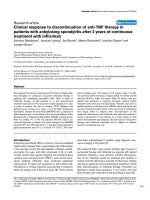Báo cáo y học: " Lymphocyte Responses to Chymotrypsin- or Trypsin VDigested b-Lactoglobulin in Patients with Cow’s Milk Allergy" doc
Bạn đang xem bản rút gọn của tài liệu. Xem và tải ngay bản đầy đủ của tài liệu tại đây (369.46 KB, 9 trang )
ORIGINAL ARTICLE
Lymphocyte Responses to Chymotrypsin- or Trypsin V-
Digested b-Lactoglobulin in Patients with Cow’s Milk
Allergy
Masashi Kondo, MD, PhD, Toshiyuki Fukao, MD, PhD, Shinji Shinoda, MD, PhD, Norio Kawamoto, MD, PhD,
Hideo Kaneko, MD, PhD, Zenichiro Kato, MD, PhD, Eiko Matsui, MD, PhD, Takahide Teramoto, MD, PhD,
Taku Nakano, PhD, and Naomi Kondo, MD, PhD
Chymotrypsin- or trypsin V- (a mixture of trypsin and chymotrypsin) digested b-lactoglobulin (BLG) peptides were prepared and
were confirmed to have much less immunoglobulin (lg)G and lgE reactivity compared with intact BLG by IgG inhibition enzyme-
linked immunosorbent assay and IgE dot blotting. The lymphocyte responses to intact BLG and these peptides were examined
using peripheral blood mononuclear cells (PBMCs) from 10 patients with cow’s milk allergy. The PBMCs from most patients had
lower lymphocyte responses to chymotrypsin- and trypsin V-digested BLG peptides than those to intact BLG. However, PBMCs from
one and two patients retained significant proliferative responses to both peptides and to only the former peptide, respectively.
Interferon-c production stimulated by chymotrypsin-digested peptides was still detectable in all five patients tested. Chymotrypsin-
digested BLG reduced lgE reactivity but still induced some lymphocyte responses.
C
ow’s milk is one of the most common food allergens
in the first year of life, with approximately 2 to 2.5%
of infants experiencing allergic reactions to it. The majority
of children outgrow their allergy to cow’s milk before the
age of 3 years, but 15% of infants with immunoglobulin
(Ig)E-mediated cow’s milk allergy retain their sensitivity
into the second decade.
1,2
The therapy for food allergy is a problem that is still to
be resolved. The first therapeutic approach to patients with
cow’s milk allergy is elimination from the diet of cow’s
milk proteins. However, this is not always easy because
cow’s milk is an essential constituent of the diet or can be
found in other foods as a hidden allergen. Moreover,
elimination from the diet may cause nutritional imbalance.
Specific allergen immunotherapy has been shown to be
effective in modulating allergic responses in diseases such
as rhinitis and asthma.
3,4
However, the ability of whole
cow’s milk to crosslink mast cell-bound IgE, resulting in
anaphylactic reaction, has limited the application of rush
immunotherapy with intact cow’s milk.
A possible immunotherapeutic approach to cow’s milk
allergy would be the use of hydrolyzed or enzymatically
digested peptides of cow’s milk, which can induce
immunomodulation by T-cell response but which do not
cause IgE-mediated reactions. Even the use of hydrolyzed
or digested peptides can cause IgE-mediated reactions if
IgE epitopes are still present in the digested peptides. On
the other hand, T-cell epitopes may not be retained by
hydrolysis or digestion. In the latter case, no immunomod-
ulation is expected.
Generally, IgE antibodies to the various allergen
components in cow’s milk proteins (such as casein and
whey proteins) are present in patients with cow’s milk
allergy. One of the major allergens in cow’s milk is b-
lactoglobulin (BLG). It has no homologous counterpart in
human milk. In rodents, partially hydrolyzed whey protein
and trypsin-digested BLG induced specific immunologic
tolerance to BLG.
5,6
These data in mice encouraged us to
use enzymatically digested peptides of BLG to induce
immunologic tolerance in patients with cow’s milk allergy.
In this study, two kinds of BLG peptides digested by
chymotrypsin alone or trypsin V (a combination of
chymotrypsin and trypsin) were prepared and reduced
IgE reactivity was confirmed. For the first step of a possible
M. Kondo, T. Fukao, S. Shinoda, N. Kawamoto, H. Kaneko, Z. Kato,
E. Matsui, T. Teramoto, N. Kondo: Department of Pediatrics, Graduate
School of Medicine, Gifu University, Gifu, Japan; T. Nakano—Research
and Development Department, Bean Stalk Snow Co., Ltd, Kawagoe,
Japan.
Correspondence to: Masashi Kondo, MD, Department of Pediatrics,
Graduate School of Medicine, Gifu University, Yanagido 1-1, Gifu, Gifu
501-1194, Japan; e-mail:
DOI 10.2310/7480.2006.00014
Allergy, Asthma, and Clinical Immunology, Vol 3, No 1 (Spring), 2007: pp 1–9 1
immunotherapy using these peptides, we analyzed the
proliferative response of peripheral blood mononuclear
cells (PBMCs) to intact BLG and to these digested peptides
in 10 patients with cow’s milk allergy.
Materials and Methods
Subjects
Fourteen healthy children (age 4 months–12 years; mean
age 3.9 years) without cow’s milk allergy and 10 children
with cow’s milk allergy (age 1–6 years; mean age 4.1 years)
were studied. Allergic symptoms such as urticaria,
erythema, and wheezing occurred in less than 1 hour after
cow’s milk ingestion in these allergic patients (Table 1).
The diagnosis of allergy to cow’s milk was based on clinical
symptoms after ingestion, including an open challenge test
and cow’s milk-specific IgE measured by CAPRAST
(Sweden Diagnostics). Cow’s milk proteins were elimi-
nated from the diets of these patients at the time of
investigation.
Preparation of Enzyme-Digested BLG Peptides
The digested peptide fragments were prepared from BLG
(Lot 51 H7210, Sigma, St Louis, MO) or edible BLG (WPI,
Auckland, New Zealand) as follows. BLG extracts (5 mg/
mL) were incubated for 6 hours at 40uC with trypsin V
(Biocon Japan, Nagoya, Japan) or chymotrypsin (MP
Biomedicals, Irvine, CA) at a final enzyme concentration
of 0.1 mg/mL. After digestion, the enzymes were
inactivated by incubation for 10 minutes at 100uC.
Sodium Dodecyl Sulphate-Polyacrylamide gel
Electrophoresis Analysis of Cow’s Milk, BLG, and
Peptides
Twenty-microlitre samples of cow’s milk (5 mg), BLG
(1 mg), and the digested BLG fragments (1 mg) were
electrophoresed on a 10 to 20% gradient sodium dodecyl
sulphate (SDS)—polyacrylamide gel at 20 mA of constant
current until the tracking dye reached the bottom of the gel.
The polypetides were visualized by Coomassie blue staining.
High-Performance Liquid Chromatography Gel
Filtration of the Digested Peptides
The preparations were subjected to high-performance
liquid chromatography gel filtration to analyze the
molecular weight distribution of the digested peptides.
The preparations were applied to TSKgelG3000PW
XL
(TOHO, Tokyo, Japan) and eluted with 0.1% trifluor-
oacetic acid and 55% acetonitrile. The column was
calibrated using standard proteins for molecular weights
as follows: a-casein (24.5 kD), BLG (18.3 kD), a-
lactalbumin (14.2 kD), aprotinin (6.5 kD), b-chain of
insulin (3.5 kD), angiotensin II (1.0 kD), and glutathione
(0.3 kD). The molecular weight of the peptides was
estimated using a calibration curve, plotting the logarithm
of the molecular weight against retention time.
IgG Inhibition Enzyme-Linked Immunosorbent
Assay
A 96-well microtitre plate (Maxisorp, NUNC, Denmark)
was coated with 100 mL of intact BLG at 1 mg/mL in 0.05 M
Table 1. Characterization of Allergic Patients
Patient Sex Age (yr)
Symptoms Caused by
Cow’s Milk Intake BA AD IgE (IU/mL)
CAP-RAST Values
Milk BLG
1 M 3 Erythema 2 + 2,200 0.78 0.37
2 F 2 Vomiting, wheezing ++ 5,000 .100.0 2.0
3 M 5 Wheezing + 2 1,500 67.0 12.0
4 M 6 Wheezing, urticaria + 2 88 4.0 ,0.34
5 F 4 Wheezing + 2 120 0.92 ,0.34
6 M 4 Wheezing, urticaria ++ 600 1.2 0.52
7 M 6 Wheezing, urticaria ++ 510 .100.0 5.2
8 F 2 Wheezing, urticaria + 2 470 16.0 ,0.34
9 M 1 Erythema ++ 190 10.0 0.86
10 M 3 Wheezing, urticaria ++ 100 13.0 1.0
AD5atopic dermatitis; BA5bronchial asthma; BLG5b-lactoglobulin; IG5immunoglobulin.
2 Allergy, Asthma, and Clinical Immunology, Volume 3, Number 1, 2007
sodium bicarbonate (pH 9.0) overnight at room tempera-
ture. After washing four times with 0.1% Tween 20 in
phosphate-buffered saline (PBST), blocking was done with
0.4% goat serum for 90 minutes at room temperature.
After washing four times with PBST, the wells were
incubated with rabbit anti-BLG antisera (50 mL, 1:64,000
dilution) and 50 mL of serially diluted samples (intact BLG,
enzyme-digested polypeptides) for 90 minutes at room
temperature. After washing four times with PBST, the
wells were incubated with a peroxidase-conjugated anti-
rabbit IgG antibody (goat) (1:10,000 dilution). After
washing four times with PBST, the plate was developed
with a peroxidase substrate buffer. After 15 minutes, the
reaction was stopped with 25 mLof4NH
2
SO
4
and the OD
was measured at 490 nm. The percentage of inhibition was
calculated as (total reactivity 2 remaining reactivity after
absorption) 3 100/total reactivity.
IgE Dot Blotting
Twenty micrograms of protein was applied onto nitro-
cellulose filter paper (0.2 mm, BioRad, CA). After washing
and blocking with 5% bovine serum albumin (BSA) in
PBS, the membranes were incubated with sera from
controls who had no specific IgE for cow’s milk or BLG
or patient 2, who had specific IgE for BLG (1:20 dilution).
The membranes were then treated with alkaline phospha-
tase-conjugated monoclonal antihuman IgE (GE-1, Sigma,
1:500 dilution) and colour-developed by a 5-bromo-4-
chloro-3-indol phosphate and nitro blue tetrazolium
solution (Sigma).
Antigen-Induced Proliferative Responses of the
PBMCs
PBMCs were isolated from heparinized blood from control
donors and patients by gradient centrifugation in Ficoll-
Paque (Pharmacia AB, Uppsala, Sweden). PBMCs were
cultured with BLG or the digested peptides at a
concentration of 20 mg/mL at 37uCina5%CO
2
-
humidified atmosphere for 5 days. Proliferative responses
to food antigens were performed as previously described.
7
Briefly, these assays were performed in triplicate in 96-well,
flat-bottomed microtitre plates (Nunclon, Roskike,
Denmark) by using 2 3 10
5
cells per well in a total
volume of 200 mL. The culture medium consisted of RPMI
1640 (Sanko Junyaku Co., Ltd, Tokyo, Japan) supplemen-
ted with 10% pooled human AB serum (Cambrex Bio
Science Walkersville Inc., Walkersville, MD),
L-glutamine
(2 mmol/L), penicillin (100 IU/mL), and streptomycin
(100 mg/mL). Proliferation was measured by [3H]-
thymidine incorporation (0.5 mCi/well) during the last
16 hours of culture. Proliferation response was measured
as the stimulation index (SI) by using the following
formula: counts per minute (cpm) incorporated into
antigen-stimulated cultures/cpm incorporated into med-
ium control.
Antigen-Induced Interferon-c Production
Culture supernatants of PBMCs stimulated with intact
BLG or the digested peptides for 5 days, as described
above, were spun to remove PBMCs and the supernatants
were frozen at 230uC until assay. Interferon-c (IFN-c)
concentration was measured with the use of a human
IFN-c enzyme-linked immunosorbent assay (ELISA)
kit (JIMRO, Takasaki, Japan); the detection limit was
15.6 pg/mL.
Statistical Analysis
Student’s t-test was used to determine significant differ-
ences in the SI between healthy controls and subjects with
cow’s milk allergy.
Results
Subjects
As shown in Table 1, we analyzed 10 patients with cow’s
milk allergy. Allergic symptoms such as urticaria,
erythema, and wheezing occurred in less than 1 hour after
cow’s milk ingestion in these patients. All patients had
cow’s milk-specific IgE, and seven of them had BLG-
specific IgE, examined by CAP-RAST.
Preparation of BLG Peptides Digested by
Chymotrypsin or Trypsin V
We focused on the allergenicity of BLG and made two
kinds of BLG peptides. We used chymotrypsin and trypsin
V to make BLG peptides. Trypsin V is a mixture of
chymotrypsin and trypsin. Figure 1 shows the digestive
sites of BLG polypeptides by these enzymes. Digestion with
chymotrypsin resulted in small peptides ranging from 3- to
31-amino acid residues whereas digestion with trypsin V
produced smaller peptides ranging from 1- to 20-amino
acid residues. As expected, these digested polypeptides
were hardly visualized by 10 to 20% gradient SDS-
polyacrylamide gel electrophoresis (Figure 2A). Figure 2B
Kondo et al, Lymphocyte Responses to Enzyme-Digested b-Lactoglobulin in Patients with Cow’s Milk Allergy 3
shows the results of gel filtration column chromatography
of intact BLG and its digested peptides by these proteases.
Both preparations retained polypeptides with a molecular
weight of around 1.6 kD. We used these peptides for
further analyses.
IgG and IgE Binding Capacity of BLG Polypeptides
We first confirmed the reduced antigenicity of these BLG
polypeptides by IgG inhibition ELISA using rabbit anti-
BLG antisera (Figure 3A). Intact BLG effectively inhibited
binding of the anti-BLG antibody in a dose-dependent
manner, and both chymotrypsin-digested peptides and
trypsin V-digested peptides had similar inhibitory capa-
cities, but they inhibited binding of the anti-BLG antibody
much less than intact BLG. As shown in Figure 2A, the
digested peptides were too small to separate in SDS-PAGE,
so we employed IgE dot blot analysis instead of IgE
immunoblot, using the controls’ and patient 2’s sera. As
shown in Figure 3B, IgE binding capacity was reduced in
chymotrypsin-digested peptides and trypsin V-digested
peptides, compared with intact BLG.
Antigen-Induced Proliferative Responses of the
PBMCs
As shown in Figure 4, the SI with BLG at concentrations of
20 mg/mL in PBMCs from 14 healthy controls without
Figure 1. b-Lactoglobulin peptide fragments generated by chymo-
trypsin or trypsin V digestion. Digestive sites by chymotrypsin and
trypsin are shown by arrows and open arrows, respectively. Trypsin V is
a mixture of chymotrypsin and trypsin.
Figure 2. Characterization of digested b-lactoglobulin (BLG) peptides. A, Sodium dodecyl sulphate (SDS)-polyacrylamide gel electrophoresis
analysis using a 10 to 20% gradient SDS-polyacrylamide gel. Polypeptides were visualized by Coomassie blue staining. Lane 1, 5 mg of cow’s milk
protein; lane 2, 1 mg of BLG; lane 3, 1 mg of chymotrypsin-digested BLG peptides; lane 4, 1 mg of trypsin V-digested BLG peptides. B, Gel filtration
analysis of BLG and its digested peptides. Calculated molecular weights for several peaks of peptides are shown above the peaks.
4 Allergy, Asthma, and Clinical Immunology, Volume 3, Number 1, 2007
cow’s milk allergy was 1.36 6 0.42. PBMCs from 3 healthy
controls and 10 patients with milk allergy were stimulated
by intact BLG and the digested peptides. The SI with BLG
was significantly higher in PBMCs from all patients than
those from healthy controls. These results indicate that the
proliferative response to BLG was present even in PBMCs
from patients with cow’s milk allergy whose CAP-RAST
score for BLG was zero. The SI with chymotrypsin-
digested BLG peptides was much lower than that with
intact BLG in PBMCs from all patients except for patient 8.
The SI with chymotrypsin-digested peptides in PBMCs
from only patients 7, 8, and 9 was significantly higher than
that in PBMCs from healthy controls. Moreover, the SI
with trypsin V-digested polypeptides tended to be similar
to or lower than that with chymotrypsin-digested ones.
PBMCs from patients 7 and 9 retained a significantly high
SI with chymotrypsin-digested BLG peptides but not with
trypsin V-digested BLG polypeptides. PBMCs from patient
8 retained a significantly high SI with trypsin V-digested
BLG peptides, as well as chymotrypsin-digested ones.
IFN-c Production from Stimulated PBMCs
IFN-c production from PBMCs stimulated with intact
BLG or chymotrypsin- or trypsin V-digested BLG peptides
were also examined (Figure 5). Supernatants of the culture
media from 5 of the 10 patients were available for this
experiment. IFN-c production by either stimulation was
under a detection limit in culture supernatants from a
healthy control. IFN-c production was also not detected in
supernatants with no stimulation but was induced in
supernatants with intact BLG stimulation from all patients
tested. IFN-c production by stimulation with the chymo-
trypsin-digested peptides was less than with intact BLG but
was still at detectable levels in supernatants from all
patients tested. IFN-c production by stimulation with
Figure 3. Evaluation of reduced B-
cell epitopes in digested peptides. A,
Immunoglobulin (Ig)G inhibition
enzyme-linked immunosorbent assay
(ELISA). Various amounts of intact b-
lactoglobulin (BLG), chymotrypsin-
digested BLG polypeptides, or trypsin
V-digested polypeptides were co-incu-
bated as inhibitors with rabbit anti-
BLG antisera in ELISA assay. B, IgE
dot blotting. Twenty micrograms of
cow’s milk, BLG, extensively hydro-
lyzed BLG (as a negative control),
chymotrypsin-digested BLG polypep-
tides, and trypsin V-digested BLG
polypeptides were applied onto nitro-
cellulose filter paper. Control and
patient 2’s sera were used as first
antibodies in IgE dot blotting.
Kondo et al, Lymphocyte Responses to Enzyme-Digested b-Lactoglobulin in Patients with Cow’s Milk Allergy 5
trypsin V-digested peptides was under a detection limit in
supernatants from patients 6 and 9.
Taken together, lymphocyte responses to chymotrypsin-
digested peptides were lower than those to intact BLG in all
patients with cow’s milk allergy, but lymphocyte responses
were still retained significantly in some patients.
Discussion
In this article, we focused on one of the major allergens,
BLG, in cow’s milk, made chymotrypsin- or trypsin V-
digested BLG peptides. Then we confirmed reduced IgE
reactivity and analyzed the lymphocyte responses to these
peptides compared with the responses to intact BLG in
patients with cow’s milk allergy as the first step in
immunotherapy with enzyme-digested BLG peptides.
Most cases of immediate hypersensitivity to cow’s milk
are mediated by IgE specific to cow’s milk constituents.
After a patient with immediate cow’s milk hypersensitivity
ingests cow’s milk, the allergens cross-link cow’s milk-
specific IgE bound to mast cells or basophils to induce the
release of multiple mediators involved in immediate
hypersensitivity reactions. The conservative therapeutic
approach to such patients is the elimination of cow’s milk
proteins from the diet.
Figure 4. Peripheral blood mononuclear cells’ (PBMCs) proliferative
response to b-lactoglobulin (BLG) and digested peptides. PBMCs from
10 patients with cow’s milk allergy were stimulated by BLG or digested
peptides at a concentration of 20 mg/mL for 5 days. Proliferation was
measured by [3H]-thymidine incorporation during the last 16 hours
of culture. Proliferative response is shown as stimulation index. *, **,
and *** indicate significantly higher stimulation index by stimulation
with intact BLG, chymotrypsin-digested peptides, and trypsin V-
digested peptides, respectively, than that in healthy controls (p , .05).
Figure 5. Interferon-c (IFN-c) production from peripheral blood
mononuclear cells (PBMCs) stimulated by b-lactoglobulin (BLG) and
digested peptides. PBMCs from 5 of the 10 patients with cow’s milk
allergy were stimulated by BLG or digested peptides at a concentration
of 20 mg/mL for 5 days. IFN-c was assayed in the supernatants of
cultured PBMCs.
6 Allergy, Asthma, and Clinical Immunology, Volume 3, Number 1, 2007
The progressive therapy for cow’s milk allergy is to
induce tolerance by immunomodulation. Oral desensitiza-
tion using intact cow’s milk was reported in a few patients
with cow’s milk allergy.
8
It took 4 to 8 months with
increasing doses of milk intake. During the desensitization
process, some mild side effects, such as angioedema and
worsening of atopic dermatitis, were reported. We also
performed oral desensitization with a similar protocol and
experienced some reactions of immediate hypersensitivity
during the therapy (unpublished observation). The ability
of whole cow’s milk to cross-link mast cell-bound IgE,
resulting in anaphylactic reactions, has limited the
application of rush immunotherapy with intact cow’s milk.
Another possible immunotherapeutic approach to
cow’s milk allergy would be the use of hydrolyzed or
enzymatically digested peptides of cow’s milk constituents,
which can induce immunomodulation by T-cell response
but which do not cause IgE-mediated reactions. There are
several formulas for milk allergy. However, the concept for
these formulas is quite different from our concept. These
formulas were made so as not to induce allergic reactions,
so extensive hydrolysis was done to destroy the T-cell
epitope and the B-cell epitope. There are several lines of
evidence for the effectiveness of such enzyme-digested
polypeptides. Chymotrypsin treatment of rye grass pollen
induced potent T-cell responses but no B-cell responses in
a murine model.
9
Pepsin-derived fragments of BSA, which
preserved T-cell epitopes, favoured immune suppression
rather than the helper T-cell function.
10
The clinical
relevance of this approach was also reported in ragweed-
sensitive patients.
11
In this study, pepsin-digested ragweed
extract was as effective as crude ragweed in the treatment
of ragweed-sensitive patients and the immediate skin test
activity of the peptic fragments was 1,000-fold less than
that of the original crude ragweed. The digested ragweed
extract was more effective than the original intact ragweed
in relieving clinical symptoms caused by ragweed.
In experimental models, induction of oral tolerance to
cow’s milk proteins using hydrolyzed peptides of BLG was
investigated in detail.
12,13
In Balb/c mice, the lengths of
potentially tolerogenic trypsin-digested BLG peptides were
distributed between 8 and 23 amino acids.
12
Feeding of
partially hydrolyzed formulas has been demonstrated to
allow the induction of oral tolerance in a rat experimental
model whereas extensively hydrolyzed formulas could
not.
13
In the literature, the tolerogenic peptide size is
around 20 amino acids.
14–16
These tolerogenic peptide
sizes are in accord with the fact that peptides with 12 to 20
amino acids presented with human leukocyte antigen
(HLA) complex class II molecules on the surface of
antigen-presenting cells are recognized by T cells.
17
The
presence of T-cell epitopes is essential for tolerogenic
peptides because immunomodulation is induced by T
cells.
18
We chose BLG as a target protein and chymotrypsin as
a digestive protease. BLG is one of the major allergens in
cow’s milk, and its molecular size is smaller than that of
casein. Chymotrypsin digestion gives six peptides with 12-
to 22-amino acid residues, which may be presented with
the HLA type II molecule on antigen-presenting cells and
which hence have possible tolerogenic capacities, as
discussed above, although a 31-amino acid peptide, an
11-amino acid peptide, two 3-amino acid peptides, and
one amino acid are also generated (see Figure 1). Trypsin
digestion gives smaller peptides than chymotrypsin diges-
tion (see Figure 1). For the comparison, we also used
trypsin V-digested BLG peptides. Since trypsin V contains
a mixture of trypsin and chymotrypsin, the resultant
peptides were smaller than peptides digested by chymo-
trypsin or trypsin.
Lymphocyte proliferative response is a useful tool for
the evaluation of food allergy, especially food-sensitive
atopic dermatitis.
7
This response requires both T cells
(predominantly CD4 lymphocytes) and monocytes as
antigen-presenting cells.
19
Since lymphocyte proliferative
response measures T-cell proliferation, which responds to
interaction among HLA class II peptide (T-cell epitope) T-
cell receptors, this assay is commonly used for the
evaluation of T-cell epitopes.
20–25
IFN-c is a cytokine
produced by T lymphocytes, which are stimulated by
interleukin-12 secreted from antigen-presenting cells.
IFN-c secretion from PBMCs is also commonly used for
the evaluation of T-cell response to food allergens and
their peptides.
26–28
PBMCs from 10 patients with cow’s milk allergy had a
significantly higher proliferative response to BLG than
those from healthy controls. We first had expected that
most PBMCs from these patients could also have given a
significant proliferative response to chymotrypsin-digested
peptides. However, chymotrypsin digestion reduced lym-
phocyte proliferation compared with intact BLG in 9 of the
10 patients, and only 3 of them showed significant
proliferation. Trypsin V digestion, as expected, reduced a
proliferation response more than chymotrypsin diges-
tion. IFN-c production from PBMCs with no stimula-
tion was under a detection limit, but IFN-c production
from PBMCs stimulated by the chymotrypsin-digested
peptides was detectable in all of the five patients avail-
able for this assay. PBMCs from patients 1, 2, and 6 did
not show a significant proliferative response to the
Kondo et al, Lymphocyte Responses to Enzyme-Digested b-Lactoglobulin in Patients with Cow’s Milk Allergy 7
chymotrypsin-digested peptides but had detectable IFN-c
production with stimulation by chymotrypsin-digested
peptides. These facts suggested that chymotrypsin diges-
tion reduced lymphocyte responses but still retained some
T-cell responses in some patients with cow’s milk allergy.
In a previous study, we demonstrated that T-cell clones
specific to BLG (YA4, HA5.7), which were established
from patients with cow’s milk allergy, needed, as a
minimum, peptide BLGp102–112 (YLLFCMENSAE) when
presented with HLA-DRB1*0405 to proliferate.
21
Unfortunately, chymotrypsin digestion does not retain
this T-cell epitope. This may be one of the reasons why
lymphocyte responses to chymotrypsin-digested BLG
peptides became lower than those to BLG.
Finally, evaluation of the residual B-cell epitope in
chymotrypsin-digested BLG is necessary for the applica-
tion of immunomodulation therapy with the peptides. We
performed inhibition ELISA using rabbit anti-BLG antisera
and IgE dot blotting using the sera of patients who had
BLG-specific IgE. These experiments clearly showed
reduced B-cell epitopes in the digested polypeptides.
However, the most reliable evaluation of the absence of
the B-cell epitope would be the skin-prick test. We are
planning to perform this test prior to clinical application
of chymotrypsin-digested BLG peptide therapy.
In conclusion, we made chymotrypsin- or trypsin V-
digested BLG peptides and analyzed the lymphocyte
responses (predominantly T-cell responses) to these
peptides. Chymotrypsin digestion decreased the lympho-
cyte responses compared with intact BLG but retained
significant responses in PBMCs from some patients with
cow’s milk allergy. Hence, chymotrypsin-digested BLG
peptides are a possible tool for immunomodulation
therapy in some patients with cow’s milk allergy,
Acknowledgements
This study was funded in part by the Research and
Development Program for New Bio-industry Initiatives
(2005,2009) of the Bio-oriented Technology Research
Advancement Institution (BRAIN), Japan.
References
1. Saarinen KM, Juntunen-Backman K, Jarvenpaa AL, et al.
Supplementary feeding in maternity hospitals and the risk of
cow’s milk allergy: a prospective study of 6209 infants. J Allergy
Clin Immunol 1999;104:457–61.
2. Sampson HA. Food allergy. Part 1: immunopathogenesis and
clinical disorders. J Allergy Clin Immunol 1999;103:717–28.
3. Ohman JL Jr, Findlay SR, Leitermann KM. Immunotherapy in cat-
induced asthma. Double-blind trial with evaluation of in vivo and
in vitro responses. J Allergy Clin Immunol 1984;74:
230–9.
4. Bousquet J, Becker WM, Hejjaoui A, et al. Differences in clinical
and immunologic reactivity of patients allergic to grass pollens and
to multiple-pollen species. II. Efficacy of a double-blind, placebo-
controlled, specific immunotherapy with standardized extracts. J
Allergy Clin Immunol 1991;88:43–53.
5. Pecquet S, Bovetto L, Maynard F, Fritsche R. Peptides obtained
by tryptic hydrolysis of bovine beta-lactoglobulin induce specific
oral tolerance in mice. J Allergy Clin Immunol 2000;105:514–
21.
6. Fritsche R, Pahud JJ, Pecquet S, Pfeifer A. Induction of systemic
immunologic tolerance to beta-lactoglobulin by oral administra-
tion of a whey protein hydrolysate. J Allergy Clin Immunol 1997;
100:266–73.
7. Kondo N, Agata H. Fukutomi O, et al. Lymphocyte responses to
food antigens in patients with atopic dermatitis who are sensitive
to foods. J Allergy Clin Immunol 1990;86:253–60.
8. Patriarca G, Nucera E, Roncallo C, et al. Oral desensitizing
treatment in food allergy: clinical and immunological results.
Aliment Pharmacol Ther 2003;17:459–65.
9. Standring R, Lavender EA, Wheeler AW, et al. Induction of T-
helper cell activity by fragments of rye grass pollen extract
produced by digestion with chymotrypsin. Int Arch Allergy Appl
Immunol 1988;87:337–41.
10. Ferguson TA, Peters T Jr, Reed R, et al. Immunoregulatory
properties of antigenic fragments from bovine serum albumin. Cell
Immunol 1983;78:1–12.
11. Litwin A, Pesce AJ. Fischer T, et al. Regulation of the human
immune response to ragweed pollen by immunotherapy. A
controlled trial comparing the effect of immunosuppressive peptic
fragments of short ragweed with standard treatment. Clin Exp
Allergy 1991;21:457–65.
12. Pecquet S, Bovetto L, Maynard F, Fritsche R. Peptides obtained
by tryptic hydrolysis of bovine beta-lactoglobulin induce specific
oral tolerance in mice. J Allergy Clin Immunol 2000;105:514–
21.
13. Fritsche R, Pahud JJ, Pecquet S, Pfeifer A. Induction of systemic
immunologic tolerance to beta-lactoglobulin by oral administra-
tion of a whey protein hydrolysate. J Allergy Clin Immunol 1997;
100:266–73.
14. Takahashi I, Nakagawa I, Kiyono H, et al. Mucosal T cells induce
systemic anergy for oral tolerance. Biochem Biophys Res Commun
1995;206:414–20.
15. Hashimura S, Fujikawa Y, Enomoto A, et al. Differential inhibition
of T and B cell responses to individual antigenic determinants in
orally tolerized mice. Int Immunol 1994;6:1791–7.
16. Hoyne G, Callow M, Kuo M, Thomas W. Inhibition of T-cell
responses by feeding peptides containing major and cryptic
epitopes: studies with the Der p1 allergen. Immunology 1994;83:
190–5.
17. Rudensky Ayu, Preston-Hurlburt P, Hong SC, et al. Sequence
analysis of peptides bound to MHC class II molecules. Nature
1991;353:622–7.
18. Mowat A. The regulation of immune responses to dietary protein
antigens. Immunol Today 1987;8:93–8.
8 Allergy, Asthma, and Clinical Immunology, Volume 3, Number 1, 2007
19. Kondo N, Fukutomi O, Agata H, et al. The role of T lymphocytes
in patients with food-sensitive atopic dermatitis. J Allergy Clin
Immunol 1993;91:658–68.
20. Inoue R, Matsushita S, Kaneko H, et al. Identification of beta-
lactoglobulin-derived peptides and class II HLA molecules
recognized by T cells from patients with milk allergy. Clin Exp
Allergy 2001;31:1126–34.
21. Sakaguchi H, Inoue R, Kaneko H, et al. Interaction among human
leucocyte antigen-peptide-T cell receptor complexes in cow’s milk
allergy: the significance of human leucocyte antigen and T cell
receptor-complementarity determining region 3 loops. Clin Exp
Allergy 2002;32:762–70.
22. Suzuki K, Inoue R, Sakaguchi H, et al. The correlation between
ovomucoid-derived peptides, human leucocyte antigen class II
molecules and T cell receptor-complementarity determining region
3 compositions in patients with egg-white allergy. Clin Exp Allergy
2002;32:1223–30.
23. Hong SJ, Michael JG, Fehringer A, Leung DY. Pepsin-digested
peanut contains T-cell epitopes but no IgE epitopes. J Allergy Clin
Immunol 1999;104:473–8.
24. Kaneko S, Furutani K, Koro O, Yamamoto S. Transient shift
toward T helper 1 cytokine production by peripheral blood
mononuclear cells following successful treatment of patients with
atopic dermatitis. Allergol Int 2003;52:21–9.
25. Kondo Y, Kakami M, Koyama H, et al. IgE cross-reactivity
between fish roe (salmon, herring and pollock) and chicken egg in
patients anaphylactic to salmon roe. Allergol Int 2005;54:317–
23.
26. Kondo N, Fukutomi O, Shinbara M, Orii T. Inhibition of
interferon-gamma and interleukin-2 production from lymphocytes
stimulated with food antigens by an anti-allergic drug. Tranilast, in
patients with food-sensitive atopic dermatitis. Biotherapy 1994;8:
19–22.
27. Dorion BJ, Burks AW, Harbeck R, et al. The production of
interferon-gamma in response to a major peanut allergy, Ara h II
correlates with serum levels of IgE anti-Ara h II. J Allergy Clin
Immunol 1994;93:93–9.
28. Liu T, Kohsaka H, Suzuki M, et al. Positional effect of amino acid
replacement on peptide antigens for the increased IFN-c
production from CD4T cells. Allergol Int 2005;54:117–22.
Kondo et al, Lymphocyte Responses to Enzyme-Digested b-Lactoglobulin in Patients with Cow’s Milk Allergy 9
